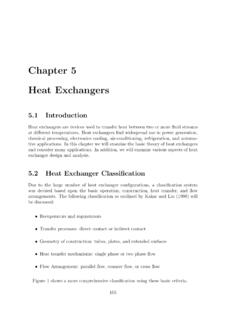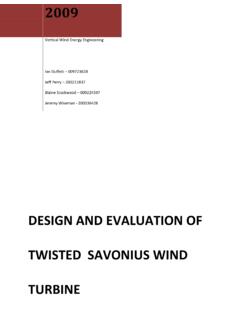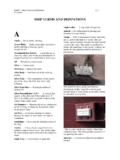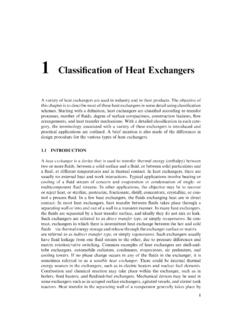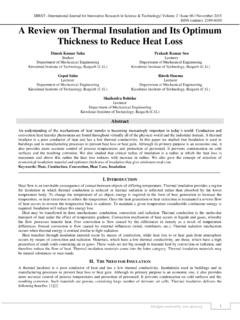Transcription of MODELS FOR PRESSURE DROP AND HEAT TRANSFER IN …
1 Journal of Enhanced heat TRANSFER , 18 (3): 191 207 (2011) MODELS FOR PRESSURE drop AND HEATTRANSFER IN AIR COOLED compact wavy FINHEAT EXCHANGERSM. M. Awad & Y. S. MuzychkaFaculty of Engineering and Applied Science, Memorial University of Newfoundland, St. John s,Newfoundland, Canada, A1B 3X5 Address all correspondence to M. M. Awad E-mail: detailed review and analysis of the thermal-hydrodynamic characteristics in air-cooled compact wavy fin heat ex-changers is presented. New MODELS are proposed which simplify the prediction of the Fanning friction factorfand theColburnjfactor. These new MODELS are developed by combining the asymptotic behavior for the low Reynolds numberand laminar boundary layer regions.
2 In these two regions, the MODELS are developed by taking into account the geomet-ric variables such as: fin height (H), fin spacing (S), wave amplitude (A), fin wavelength ( ), Reynolds number (Re),and Prandtl number (Pr). The proposed MODELS are compared with numerical and experimental data for air at differentvalues of the geometric variables obtained from the published literature. The new MODELS forfandjcover a wide rangeof the Reynolds number. Since the model is based analytically, it will also allow for proper design assessment of heatexchanger WORDS: compact heat exchangers, wavy fins, MODELS , friction factor, Colburn factor, performancemodeling1.
3 INTRODUCTIONThis paper, which contains three major sections, presentsthe results of a robust modeling approach for wavy first section gives a review of the data and correla-tions, which are presently available in the open , a discussion on the development of a simple asymp-totic model for the prediction of the Fanning friction fac-tor (f) and the Colburn factor (j) for the wavy fin ge-ometry is presented. Finally, a discussion of the proposedmodels and a comparison with published data for air wavy fin geometry shown in Fig. 1 is widelyused in air-cooled heat exchangers and heat sink waviness contributes to heat TRANSFER enhancement bymeans of an increased surface area due to corrugationsand turbulence promotion at larger flows.
4 At moderateReynolds numbers, re-circulation zones form periodicallyand provide enhancement by means of turbulent mixingof the fluid and boundary layer 1: wavy fin LITERATURE REVIEWA number of previous studies investigating the thermaland hydraulic characteristics of the wavy fins have beenreviewed for this work. While predominantly used with1065 5131/11/$ 2011 by Begell House, & MuzychkaNOMENCLATURE2 Atwice the wavy fin amplitude, mcpheat capacity, diameter, meerrorE( )complete elliptic integral second kindfFanning friction factor, = m/( mu2m)Hfin height, mhheat- TRANSFER coefficient, W/m2 KjColburn factor, = StPr2/3 Kconsistency index, nkthermal conductivity, W/m KLchannel length, mL+dimensionless hydrodynamic entrancelength, =L/DhReDhLdwavy fin length, mLeeffective length, mnpower-law indexNuNusselt number, =hDh/kPrPrandtl number, = cp/kReReynolds number, = umDh/ Reggeneralized Reynolds number, = u2 nmDnh/KRHrelative humidityrhhydraulic radius, mSfin pitch, mStStanton number, = Nu/(RePr)tfin thickness, mummean velocity, m/sGreek Symbols cross-section aspect ratio, = (S/H) wavy -fin-channel spacing ratio,= (S/2A)
5 wavy -fin-channel corrugation ratio,= (2A/ ) wavy fin wavelength, m dynamic viscosity, N s/m2 corrugation angle, fluid density, kg/m3 wall shear stress, N/m2 Subscriptsappapparentasyasymptoticbbulk valuechannelchannelDhbased on hydraulic diameterH1uniform heat flux boundary conditionmmeanTconstant wall temperature boundaryconditionwat wall conditionswavywavy finAcronymsCFDcomputational fluid dynamicsFPIfin per inchLBLlaminar boundary layerNTUnumber of TRANSFER unitsOSFoffset strip finRMSroot-mean-square errorair as a working fluid, few studies have addressed issueswith liquids. Early data on wavy fin geometries can befound in Kays and London (1984) for three sets of geo-metric parameters using air as a working fluid.
6 These ge-ometries had (fins per inch) FPI = , , and ,respectively with = in ( mm).Goldstein and Sparrow (1977) studied corrugatedchannels with triangular waves. Although triangularwaves were somewhat different from sinusoidal waves,many flow features were common to both triangularwaves and sinusoidal waves. They were among the firstto provide detailed data on triangular waves. They car-ried out experiments based on the naphthalene sublima-tion technique to determine the local and average transfercharacteristics for flow in a corrugated wall channel. Therange of their experiments encompassed the laminar, tran-sition, and low-Reynolds-number turbulent regimes (Re =150 2000).
7 They used two corrugation cycles (two wave-lengths). They measured local mass TRANSFER in the span-wise ( , cross stream) and streamwise directions. Theyalso determined overall TRANSFER rates. The experimentsdemonstrated the presence of different complex trans-port processes and related fluid flow phenomena. Theseincluded secondary flows and associated spanwise masstransfer variations, suppression of the secondary flow bycounteracting centrifugal forces, and destruction of thesecondary flow by the onset of turbulence. Flow separa-tion on the leeward faces of the corrugated wall causedJournal of Enhanced heat TransferPressure drop and heat TRANSFER in wavy Fin heat Exchangers193a sharp decrease in the local TRANSFER rates, but relativelyhigh TRANSFER rates were in evidence in the reattachmentregion.
8 In the laminar range, they found that the aver-age TRANSFER coefficients for the corrugated wall channelwere only moderately larger than those for a parallel-platechannel. On the other hand, in the low-Reynolds-numberturbulent regime, they found that the average TRANSFER co-efficients for the corrugated wall channel were about threetimes larger than those for a parallel-plate channel, butthere was an even greater penalty in pumping Brien and Sparrow (1982) performed experimentsto determine forced convection heat - TRANSFER coefficientsand friction factors for flow in a corrugated duct.
9 The cor-rugation angle was 30 and the inter wall spacing wasequal to the corrugation height. The range of the Reynoldsnumber, based on the duct hydraulic diameter was from1500 to 25000, and the range of the Prandtl number wasfrom 4 to 8 by varying the temperature level of visualization, using the oil-lampblack technique, re-vealed a highly complex flow pattern, including largezones of recirculation adjacent to the rearward-facing cor-rugation facets. Their heat TRANSFER correlation wasNu= (1)In the above equation, the value of the Reynoldsnumber exponent was low when compared to the ex-ponent for a standard turbulent duct flow situation be-cause the corrugated duct flow had large zones of recir-culation not present in conventional duct flows.
10 The of the Prandtl number exponent in Eq. (1) was in-termediate with respect to other values found in the lit-erature for turbulent flows that ranged from to an exponent of 1/3 being quite common in the lit-erature. The enhancement of heat TRANSFER as comparedto a conventional parallel-plate channel was about a fac-tor of Friction factors obtained from measured axialpressure distributions were virtually independent of theReynolds number and equal to , a value appreciablygreater than that for unidirectional duct and Comb (1983) measured heat TRANSFER , PRESSURE drop , and observed fluid flow experimentallyfor water flowing in a corrugated-wall duct.

